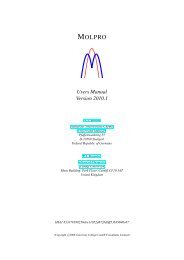Carbon−Carbon Coupling Reactions Catalyzed by Heterogeneous ...
Carbon−Carbon Coupling Reactions Catalyzed by Heterogeneous ...
Carbon−Carbon Coupling Reactions Catalyzed by Heterogeneous ...
You also want an ePaper? Increase the reach of your titles
YUMPU automatically turns print PDFs into web optimized ePapers that Google loves.
<strong>Heterogeneous</strong> Pd <strong>Catalyzed</strong> C−C <strong>Coupling</strong> <strong>Reactions</strong> Chemical Reviews, 2007, Vol. 107, No. 1 165<br />
demonstrated in Table 76. In all cases, high conversions,<br />
selectivities, and TOF were achieved.<br />
Table 76. Synthesis of 2-Arylpropionic Acids 196 <strong>by</strong> Pd/<br />
C-<strong>Catalyzed</strong> Carbonylations<br />
substrate t (h) conv (%) select. (%) TOF (h-1 )<br />
193a 4.2 96 99.2 3375<br />
194a 4 92 99.1 3400<br />
195a 4 90 99.3 3300<br />
193b 13 90 98 1010<br />
194b 4.6 92 98 2900<br />
193c 24 90 99 552<br />
Esters 197 were obtained, when the Pd/C-catalyzed<br />
carbonylation 62 was carried out in the presence of alcohols<br />
(Scheme 53).<br />
Scheme 53. Pd/C-<strong>Catalyzed</strong> Alkoxycarbonylation<br />
As an alternative, esters and also anilides could be<br />
synthesized <strong>by</strong> Pd-catalyzed carbonylation of aryl iodides<br />
or activated aryl bromides in the presence of butanol or<br />
aniline, respectively, using a silica-supported bidentate arsine<br />
palladium complex “Si”-2As-Pd(II) under atmospheric<br />
conditions (Scheme 54). 250 The catalyst showed high activity<br />
and could be recovered and reused.<br />
Scheme 54. Carbonylations <strong>by</strong> Silica-Supported Bidentate<br />
Arsine Palladium Complex<br />
8.3. r-Arylations of Diethyl Malonate<br />
The homogeneous palladium-catalyzed arylation of carbonyl<br />
compounds using aryl halides has become a useful<br />
and general synthetic method. 251-254 The reaction could also<br />
be catalyzed in heterogeneous fashion with diethyl malonate<br />
as the carbonyl compound. 255 For aryl bromides 200, Pdexchanged<br />
NaY zeolites ([(Pd(0)], [(Pd(II)], and entrapped<br />
[(Pd(NH3)4]) exhibited good activity at low Pd concentrations<br />
(2 mol %) (Table 77). The catalysts could easily be separated<br />
and reused without a real loss in activity (entries 1-4).<br />
8.4. Arylations of Aromatic Compounds<br />
Pd-catalyzed arylation reactions of arenes <strong>by</strong> haloarenes<br />
to biaryl products were successfully applied in intermolecular<br />
fashion to a variety of heterocyclic arenes 256-258 and arenes<br />
possessing a directing group. 259-261 In an intramolecular<br />
fashion, five- and six-membered rings were formed. 262-265<br />
In these couplings, hydrogen halide is eliminated. Palladium<br />
hydroxide on carbon (Pearlman’s catalyst) effectively cata-<br />
Table 77. Pd/Zeolite-<strong>Catalyzed</strong> r-Arylations of Diethyl<br />
Malonate a<br />
entry catalyst R<br />
GLC<br />
yield (%)<br />
isolated<br />
yield (%)<br />
1 Pd(0)-NaY Me 31 (33) b 21<br />
2 Pd(II)-NaY Me 41 (38) b 32<br />
3 Pd(OAc)2-NaY Me 41 (39) b 29<br />
4 Pd(NH3)4-NaY Me 51 (49) b 38<br />
5 Pd(NH3)4-NaY OMe 57 45<br />
6 Pd(NH3)4-NaY H 47 41<br />
7 Pd(NH3)4-NaY F 64 50<br />
8 Pd(NH3)4-NaY Ac 70 60<br />
9 Pd(NH3)4-NaY NO2 98 84<br />
a Reaction conditions: 15 mmol of aryl bromide, 10 mmol of diethyl<br />
malonate, 20 mmol of base, 2 mol % Pd-catalyst, 6 mL solvent, 110<br />
°C, 20 h. b Yield of second run in parentheses.<br />
lyzes arylation reactions of aryl iodides and bromides,<br />
providing excellent arylation-to-hydrodehalogenation ratios<br />
(>30:1) with a broad scope for both intra- (Table 78) and<br />
intermolecular arylation processes (Table 79). 29,266 The<br />
studies indicated that an active homogeneous palladium<br />
species is produced under the reaction conditions.<br />
Table 78. Scope of Intramolecular Direct Arylation <strong>Reactions</strong> a<br />
a Conditions: substrate, KOAc (2 equiv), and Pd(OH)2/C (10 mol<br />
%) added to a screw cap vial followed <strong>by</strong> DMA (0.2 M) and heating<br />
to 140 °C for 12-24 h. b Isolated yield. c 20% of hydrodebrominated<br />
product was also obtained.












![Hetero [6+3] Cycloaddition of Fulvenes with N-Alkylidene Glycine ...](https://img.yumpu.com/35423358/1/190x245/hetero-6-3-cycloaddition-of-fulvenes-with-n-alkylidene-glycine-.jpg?quality=85)




